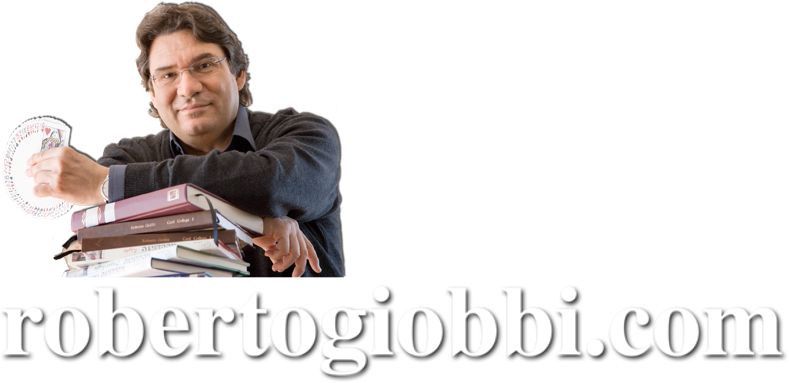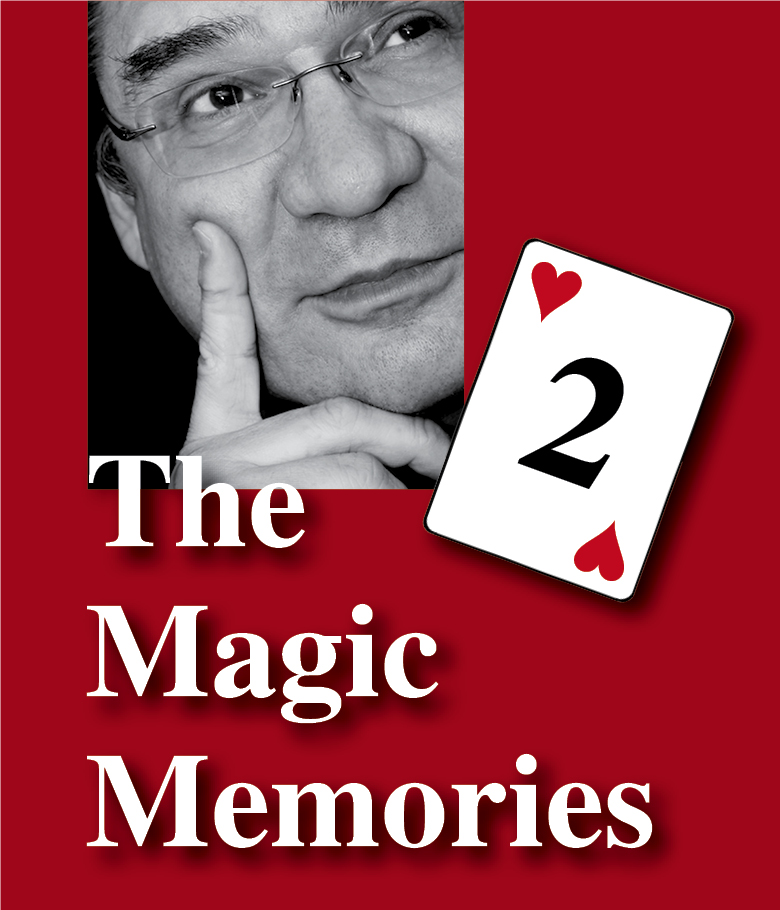
Hello everyone!
Today’s topics are: An Additional Thought on “And Yet It Is!”; Countdown Stop Trick; The Finest Magic of Pedro Lacerda.
These are The Magic Memories 162, gone online Sunday, February 4th, 2024, at 0:07h sharp.
All The Magic Memories from 2021, 2022, and 2023, including the Magic Advent Calendar from 2020, can be found HERE.
An Additional Thought on “And Yet It Is!”
In The Magic Memories 160 I gave a few ideas on “And Yet It Is”, a lovely trick from Stand-up Card Magic.
My good friend and cardician extraordinaire Gary Plants wrote in and had this to say:
Roberto, the idea of forcing one of TWO cards is very good. The fact that either card could be selected is nice. Since the two cards are set ahead of time, I would consider to set up 3-4 pairs that could be forced and are easy to remember.
Now you can be even more free with the selection (force).
Just a thought.
Gary Plants
Goes without saying that this is a good idea, especially when performing in front of a lager audience, where you want methods to be as fool-proof as possible.

Countdown Stop Trick
Talking about tricks and how to make them better, or safer, or both: In Card College Volume 5 there is a “Countdown Stop Trick”, my interpretation of a very terse note in the infamous Dr. Jacob Daley Notebooks. Below is a screenshot of the intro to remind you – look up the details in the book, please:
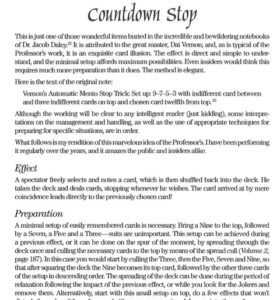
Years ago, Helder Guimaraes came to see me at my home in Muttenz, and we had a Swiss Fondue, his first, I believe to remember 🙂
And of course we talked lots of magic. Among many other things Helder suggested a change in the set-up of the “Countdown Stop”; as you will see this is an excellent idea, and one wonders why nobody thought of it before. Of course, today, several years later, Helder has become a young star of magic, and this simple idea here shows why this is so.
This is another handling of “Countdown Stop” from Card College 5. The idea of using even instead of odd cards is from Helder.
Set-up
From top down in the face-down deck: 10, 8, 6, 4, 2 (suits do not matter).
Do a Slough-off Faro to alternate the set-up with x-cards, the Ten still on top.
An easy way to obtain this set-up is to start out by spreading the cards face up and to cull one after the other a Two, a Four, a Six, an Eight and a Ten to the top of the deck. Of course it would be nice if you had a reason to do so… or just do it in a moment of relaxation between two tricks, no problem in an informal situation.
To make this very elegant, either have the deck pre-set from the outset, then delay the set-up with one or two tricks, or obtain the set-up in the course of a preceding trick (see “Secret Setup”, still in Card College Volume 5, p. 1124), delay with another trick, and then go into “Countdown Stop”; such a procedure will deceive even knowledgeable pople…
Method
Spread the cards between your hands to have one selected, counting in 3-2-2-3 rhythm and trying to have the spectator take the eleventh card from the top. After the cards has been noted by the audience, have the spectator replace his card from where he took it from, in case he took the eleventh card.
If he did not, use the “Crocodile Technique” or other shenanigan you know to get the selection there.
In any case the spectator’s card ends up eleventh from the top, without disturbing the location and order of the set-up.
In an Injog Shuffle add five indifferent cards to the top. Use the “Intelligent Injog Shuffle” from Sharing Secrets (p. 54).
A brief check-up will reveal the selection to be at position sixteen from the top. If it is not, either my description is wrong, or you made a mistake…
Hand the deck to the spectator, and then proceed as explained in the book, to wit: Ask her to deal cards one by one on the table. As soon as she has dealt two or three cards, add that she may stop whenever she wants.
For years I had her deal the cards face down, until I realized that the set-up is well hidden, so that you may ask her to deal the cards face up; this will take some extra performance stress from you, as you will not have to silently count cards (easy to miss if you do not do this every day). See also “later addition” below.
If she deals too quickly, do a “slow-down” gesture with both hands, as you say, “Deal them with dignity, please, with dignity.” I must praise myself for this phrasing, as nobody knows exactly what it means, but I can assure you from many years of professional experience that saying so, accompanied by said gesture, will make everyone slow down!
Regardless of where she stops, use the card she just deal or the next one to count down to the selection.
I leave the presentation to you, or check mine in the book.
Later addition: In order to eliminate any memory work, have spectator deal the cards face up, so you see exactly which card to use as the “countdown card”. This also gives you an automatic out, in case she deals over her selection: Simply use the “Circus Card Trick” ploy, i.e. stop her a few cards past the selection and say, “The next card to be turned over, will be your card.” Do not wait until she turns over the card, but directly reach into the pile of dealt cards and turn the selection face down. If she prematurely turns over the next card, without missing a beat reach into the pile and turn over the selection saying, “No, this one!”
Not as good as the original trick, but good enough. Alternatively, go the way of “The Trick That Cannot Be Explained” by using the card she stops at to get to the selection. Or make up your own out, there are some nice solutions 🙂
The Finest Magic of Pedro Lacerda
Just received the book from my dear friend in Portugal, Pedro Lacerda. Pedro justifies a book, and well, here it is!
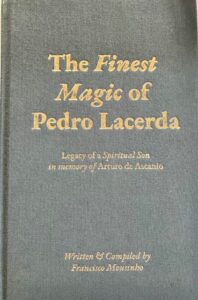
Pedro is one of those few inspired amateurs who could compete with any seasoned professional.
He gained a lot of performing experience in the eighties and Nineties, did several lecture tours that took him around the world, but then decided to follow Vernon’s advice to keep magic as a hobby (he does so at a very high level) and became a very successful businessman in Portugal.
Best of all, of course, for most of my readers: The book is in English! Although occasionally it shines through that the author is not a native English speaker, all is absolutely intelligible and clearly explained, with lots of excellent photos.
In the first 86 pages you will learn more about Pedro Lacerda, the person, and magic in Portugal in general. Also, that he is one of Ascanio’s “spiritual sons”, which shines through in his thinking and performance. The tricks and techniques are all from his performing repertoire and most effective.
All is interesting, really, but two pieces stand out: First, his borrowed ring on tie – this is one of his signature pieces.
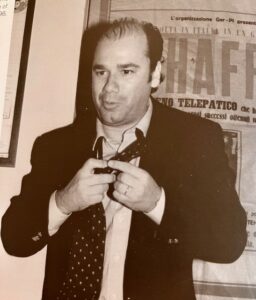
Second, his signed card to piano key, a pièce de resistance he used to do when he performed in a magic bar in Portugal during his most active days: In the deck of cards suddenly a piano key appears, as the pianist at the same time plays a wrong key. It turns out that the performer’s key is the one missing from the piano, while the signed card is now in its place in the piano. Good and original.
This is your chance to get a piece of outstanding Portuguese magic in your library.
For more information about the book and how to get it, email the author Francisco Mousinho at franciscomousinho96@gmail.com or Instagram: francisco_mousinho.
Wish you all a successful and happy week,
Roberto Giobbi
